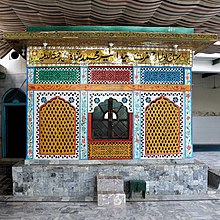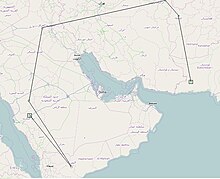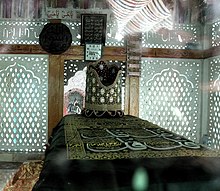Sayyid Muhammad ibn Shuja' al-Din al-Husayni al-Makki (Arabic: السيد محمد الحسيني المكي), 1145–1246, also known as Sayyid Mahmood Shah al-Makki (Urdu: سيد محمود مكي) was the ancestor of the Bukkuri or Bhaakri Sayyids (Urdu: بهاكري سادات), who founded Bukkur in Sindh.[1]
Muhammad bin Shuja' al-Dīn محمد بن شجاع الدين (Arabic) | |
|---|---|
 The historical tomb of Sayyid Muhammad. | |
| Born | 1145 |
| Died | 1246 (aged 101) |
| Resting place | Sindh, Pakistan |
| Title | Sayyid |
| Children | Sayyid Sadruddin Sayyid Badruddin Sayyid Maah Sayyid Shams |
| Parent | Sayyid Muhammad Shuja' al-Dīn |
| Relatives | Jalaluddin Surkh-Posh Bukhari Shahab al-Din Abu Hafs Umar Suhrawardi |


Birth and upbringing
editThe father of the Sayyid was Abu Ahmad Muhammad Shuja who married daughter of Abu Hafs Umar al-Suhrawardi in Baghdad. Sayyid Muhammad was born in 1145 (Islamic year of 540 AH) to the couple.[2] Some scholars however disputed this marriage of Sayyid Muhammad Shuja to a daughter of al-Suhrawardi and have mentioned that it was Sayyid Muhammad al-Makki himself who married the daughter of al-Suhrawardi.[3][4][5]
Sayyid Muhammad decided to leave Yemen for Sindh, claiming he saw his ancestor, the Islamic prophet Muhammad in his dream instructing him to leave for India as it awaited him.[6]
In Sindh
editIt is mentioned in many sources that Sayyid Muhammad al-Makki arrived in Bukkur at dawn.
Delighted at the peaceful setting and beautiful view of the sun rising, he famously and joyfully exclaimed: "God has ordained my morning in this blessed place!" (Arabic: ! جعل الله بكرتي في البقعة المباركة). Sayyid Muhammad also named this place 'Bukkur' from its former name 'Fareshta'.[7] Upon being asked where he wanted to live by the welcoming natives he told them he wanted to live where the cowbells could be heard and the rising sun would be visible. Sayyid Muhammad al-Makki obtained a grant of land in Rohri with the condition expressed in the deed that he should cultivate the land in lieu of the military duties obligatory on all granted landowners.[8] Due to the warlike nature of this tribe, they were entrusted by the authorities to prevent marauders and bandits from thieving and looting.[9] Sayyid Muhammad al-Makki became a well-known saint whose preaching brought many people towards Islam. He established a centre of spiritual learning in Sindh and remained the religious figure of Sindh until the early 13th century.
Death
editMuhammad al-Makki died at the age of 101 in 1246 AD and 644 AH. He was buried in the fort of Arak between Sukkur and Bukkur[10] His shrine is located near Deputy Commissioner Office Sukkur. Location of Shrine Of Muhammad Al Makki In Sukkur
Descendants
editMakhdoom Muhammad Badruddin Bhaakri
editHis descendants include Sayyid Muhammad Mahdi who was born from the daughter of Alauddin Khalji,[11] Sayyid Sa'adullah[12] and Waris Shah, the author of Heer Ranjha, the famous romantic story.[13][14][15][16][17]
Sayyid Sadruddin al-Khatib
editThe saint Sayyid Sadruddin, the son of Sayyid Muhammad Shah al-Makki was born in 1204 in Bukkur. His influence spread all around the Indian Sub-Continent and was well known for his spirituality. He spent most of his life travelling and seeking knowledge from other parts of the world. He died in 1270 and is buried on Bukkur Island.[18]
Sayyid Sadruddin's son Ali Badruddin had many sons including Sayyid Murtadha also known as Shaban ul Millat,[19] whose descendants are found mostly in Allahabad in India. From the descendants of Sayyid Ali Badruddin comes the author of Manba Al-Ansab, Sayyid Muin Al-Haqq and many other famous historical personalities. Other sons of Sayyid Ali Badruddin are Sayyid Daulat Ahmad, Sayyid Nazamuddin, Sayyid Ruknuddin and Sayyid Muhyuddin.[20]
References
edit- ^ Mawsū'at Al-Hussainiyah. Vol. 3. Dār al-Arabiyah Lil Mawsū'aat. 2009. p. 706.
- ^ Thattavi, Meer Qane, ed. (2006). Tuhfatul Kirām. Sindhi Adabi Board. p. 386.
- ^ Al-Haqq, Sayyid Muīn, ed. (2010). Manba Al-Ansab Urdu Translation. Madrassa Faydan Mustafa. p. 318.
- ^ Zulfiqar Ali K. "The Rizvi Saints of Sindh - Part. I Archived 2015-04-02 at the Wayback Machine
- ^ Abdul Hayy, Sayyid, ed. (1999). Nuzhat Al-Khawātir. Dār Ibn Hazm. p. 166.
- ^ Al-Haqq, Sayyid Muīn, ed. (2010). Manba Al-Ansab Urdu Translation. Madrassa Faydan Mustafa. p. 316.
- ^ Abdul Hayy, Sayyid, ed. (1999). Nuzhat Al-Khawātir. Dār Ibn Hazm. p. 166.
- ^ Ross, David (1883). The Land of Five Rivers and Sindh. Chapman and Hall. p. 69.
- ^ Balfour, Edward Green (1885). The Cyclopaedia of India and of Eastern and Southern Asia. Lawrence & Adelphi Presses. p. 434.
- ^ Storey, C.A., ed. (2002). Persian Literature: A Bio-Bibliographical Survey. Vol. 1. Psychology Press. p. 949. ISBN 9780947593384.
- ^ Shah, Sayyid Amin Ali (ed.). Shajrat Al-Hussainiyah. Jami' Al-Ameeniyah Al-Ridhawiyyah. p. 130.
- ^ Shah, Sayyid Amin Ali (ed.). Shajrat Al-Hussainiyah. Jami' Al-Ameeniyah Al-Ridhawiyyah. p. 130.
- ^ Naqvi, Sayyid Maqsood, ed. (1991). Riaz Al-Ansab. Izhar Sons Printer. p. 684.
- ^ Al-A'raji Al-Hamadani, Sayyid Qamar, ed. (2016). Kitab Mudrik At-Talib. Vol. 1. Idara Niqabat Sadat Al-Ashraf Pakistan. p. 436. ISBN 9789699836022.
- ^ Rajāi, Sayyid Mahdi, ed. (2006). Al-Mu'aqqabūn. Vol. 3. Mu'asassah Āshūra. p. 35. ISBN 9789647263580.
- ^ Al-A'raji, Sayyid Ja'far, ed. (1998). Manāhil Al-Darab Fī Ansāb Al-Arab. Vol. 1. Al-A'raji. p. 420. ISBN 9789646121232.
- ^ Abu Sa'eeda, Sayyid Hussain, ed. (2004). Mashjar Al-Wāfi. Dār Muhajjat Al Baydā'. p. 122.
- ^ Abdul Hayy, Sayyid, ed. (1999). Nuzhat Al-Khawātir. Dār Ibn Hazm. p. 173.
- ^ Abdul Hayy, Sayyid, ed. (1999). Nuzhat Al-Khawātir. Dār Ibn Hazm. p. 180.
- ^ Al-Haqq, Sayyid Muīn, ed. (2010). Manba Al-Ansab Urdu Translation. Madrassa Faydan Mustafa. p. 317.